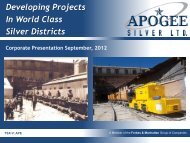Pulacayo Project Feasibility Study - Apogee Silver
Pulacayo Project Feasibility Study - Apogee Silver
Pulacayo Project Feasibility Study - Apogee Silver
You also want an ePaper? Increase the reach of your titles
YUMPU automatically turns print PDFs into web optimized ePapers that Google loves.
<strong>Pulacayo</strong> 1 000 t/d Phase I <strong>Feasibility</strong> <strong>Study</strong> - NI 43-101 Technical Report<br />
090644-3-0000-20-IFI-100<br />
Should levels significantly exceed any of the thresholds certain smelters may choose not to<br />
consider such concentrates for their feed mix.<br />
19.3.2.2 Lead Concentrates<br />
At around 48% Pb, the <strong>Pulacayo</strong> concentrates can be considered medium-grade with several<br />
internationally traded qualities running both higher and lower than these levels. The silver level in<br />
the concentrates can be considered relatively high, which will likely make these, concentrates<br />
less attractive to Chinese smelters because of the prevailing negative arbitrage between the<br />
LBMA and Shanghai prices.<br />
Elements commonly found in lead concentrates, which are typically subject to penalties, and their<br />
thresholds are:<br />
Table 19.9: Elements Commonly Found in Lead Concentrates Which are Typically Subject to<br />
Penalties and their Thresholds<br />
Element<br />
Typical Penalty Thresholds<br />
As 0.2 to 0.5%<br />
Sb 0.2 to 0.5%<br />
Zn 5 to 7%<br />
F+Cl<br />
500 to 800 ppm<br />
Based on the information available, arsenic and antimony levels are both seen to be well above<br />
typical penalty thresholds and, on a standalone basis, might make these concentrates less<br />
attractive to certain buyers for, at a combined 2.6 to 2.8% arsenic +antimony, the level is quite<br />
high. While Chinese smelters can typically handle antimony at these levels - in fact, many<br />
smelters in southern China like antimony unfortunately, this is not the case at many Western<br />
plants, as the overall load of arsenic and antimony will affect product and by-product quality. As<br />
such, although most plants in theory could handle the concentrate the quantity that each plant<br />
might accept will vary dramatically.<br />
In addition to the arsenic and antimony, the silver content may determine the final homes for this<br />
material for, as highlighted in this report; high silver-bearing concentrates are a very difficult fit for<br />
the Chinese market. This can be expected to lead to additional charges being incurred via higher<br />
silver refining charges, higher treatment charges, or both.<br />
In addition to these elements, other potential quality issues with the lead concentrates include:<br />
<br />
The lead grade at 46 to 50% is acceptable for China and in many cases preferable,<br />
although this is not the case in the West where most plants generally look for higher grade<br />
concentrates;<br />
<br />
Zinc at 3.5% would be attractive to the Chinese however, it is generally an undesirable<br />
element at most Western plants, and although at these levels, it is unlikely to be a<br />
significant issue.<br />
Despite the above, it is not believed that quality issues would preclude sales of these<br />
concentrates, as there are other means of managing the impurities. Accordingly, regardless of<br />
TWP Sudamérica S.A. Av. Encalada 1257 Of. 801, Santiago de Surco Lima 33, Perú (51-1) 4377473<br />
Page 225



